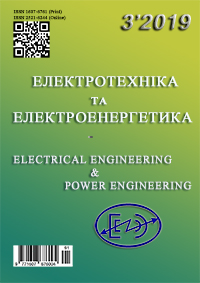ANALYSIS OF THE STABILITY OF THE ELECTRICAL POWER SUPPLY SYSTEM OF THE WELDING ELECTRIC AND PLASMA ARC
DOI:
https://doi.org/10.15588/1607-6761-2019-3-4Keywords:
stability, power supply system, electric arc, the arc inertiaAbstract
Purpose. Consideration of issues related to the stability problem of the "power source - electric arc" system with small disturbances and its solution in the framework of the method of small oscillations. Discussion of the choice of a mathematical model, the presentation of an effective approach to solving stability problems, based on the use of general equations of quasistationary modes for the analytical description of AC circuits.
Methodology. In methodological terms, the article is based on the well-known classical principles of the general theory of stability. Basically, stability under small perturbations is considered and methods are used that are based on the analysis of differential equations of the first (linear) approximation, which have received fruitful application and development in the theory of automatic control.
Findings. Examples of solving specific problems of stability in analytical, as well as in graphic or graphoanalytic form, are important in the formation and approval of theoretical principles. Unlike numerical solutions, they illustrate more clearly all the characteristic aspects of the problem. In particular, they are a good illustration of the distinctive side of the aperiodic stability problem that its solution depends solely on the static characteristics of the system elements and can be obtained within the framework of only finite equations, and the resistance coefficient can be used as a stability criterion.
Originality. The well-known method was further developed in relation to a new object of study - a soft-switching converter operating on an electric arc. Special attention has been paid to a clearer formulation of the problem and a more differentiated assessment of its acceptability for the given technical system.
Practical value. In connection with the continuous development of individual power supply systems, the importance of the problem of their sustainable operation is growing even more. The article can serve as a real basis for a constructive solution to the problems of the general theory of stability of new power supplies for technological loads, contribute to the creation of favorable conditions for its further fruitful development, as well as for the development of new effective methods for solving specific problems of interest to specialists in the field of power supply systems of electrotechnological installations.
References
[1] Vereshhago, E.N. Fel’dsher, I.F., Kostjuchenko, V.I. (2007). Kvazirezonansnye invertory v ustrojstvah jelektropitanija dlja vozdushno-plazmennoj rezki [Quasiresonant inverters in power-supply devices for air-plasma cutting]. Technical electrodynamics. Ch. 4, 8-11.
[2] Vereshhago, E.N., Fel’dsher, I.F., Kostjuchenko, V.I.,. (2007). Analiz jelektromagnitnyh processov v FB-ZVS-PS DC-DC konvertore s LCC-konturami [Analysis of electromagnetic processes in FB-ZVS-PS DC-DC converter with LCC circuits]. Bulletin of Khmelnitsky National University. 2 (1), 225-229.
[3] Vereshhago, E.N., Kvasnickij, V.F., Miroshnichenko, L.N., Pentegov, I.V. (2000). Shemotehnika invertornyh istochnikov pitanija dlja dugovoj nagruzki. Nikolaev: UGMTU, 283.
[4] Kostjuk, O.M. (1983). Jelementy teorii ustojchivosti jenergosistem. Kiev. Naukova dumka, 296.
[5] Korsunov, K.A., Kaljuzhnyj, G.S., Lyshtvan, E.Ju. (2015). Analiz dinamicheskih uslovij ustojchivosti jelektricheskoj dugi v kanale plazmotrona [Analysis of the dynamic stability conditions of the electric arc in the plasma torch channel]. Advances in Applied Physics. Moscow. Ch. 3, 3, 250-253.
[6] Ustojchivost’ gorenija jelektricheskoj dugi (1973). Novosibirsk: In-t teplofiziki ANSSR, 151.
[7] Leskov, G.I. (1970). Jelektricheskaja svarochnaja duga. Moscow. Mashinostroenie, 335.
[8] Sidorec, V.N., Pentegov, I.V. (2013). Determini-rovannyj haos v nelinejnyh cepjah s jelektricheskoj dugoj. Kiev. Mezhdunarodnaja associacija «Svarka», 272.
[9] Mayr, O. (1955). Uber die Stabilitatsgrenze des Schaltlichtbogens. Report of the international simposium on electrical discharges in gases. Delft, 1-64.
[10] Heuvel, W.M.C. (1966). Interruption of small inductive currents in A.C. circuits. Diss., Eindhoven, 99-122.
[11] Vereshchago, Y.N., Kostyuchenko, V.I. (2014). A physical–mathematical model of the power circuit of a plasma torch. Welding International, 28, 2, 133-139. DOI: 10.1080/09507116.2013.796664
[12] Vereshchago, Е.N., Kostyuchenko, V.I. (2014). A Simulation Model of Electric Arc. Russian Electrical Engineering. 85, 6. 376-381. DOI: 10.3103/S106837121406011X
[13] Deisch, C.W. (1978). Switching control method changes power converter into a current source. IEEE Power Electronics Specialist Conf., 300-306.
[14] Ridley, R.B. (1990). New Small-Signal Model for Current-Mode Control PhD Diss. Virginia Polytechnic Inst. And State Univ., November, 325.
[15] Horowitz, I.M. (1963). Synthesis of Feedback Systems, Academic Press, 740.
[16] Wildrick, C.M., Lec, F.C., Cho, B.M., Choi, B., (1995). A method of defining the load impedance specification for stable distributed power system. IEEE Transactions on power electronics. 10, 3. 280-284.
Downloads
Published
How to Cite
Issue
Section
License
Copyright (c) 2019 YE.M. Vereshchaho, V.I. Kostiuchenko

This work is licensed under a Creative Commons Attribution 4.0 International License.
Creative Commons Licensing Notifications in the Copyright Notices
Authors who publish with this journal agree to the following terms:
Authors retain copyright and grant the journal right of first publication with the work simultaneously licensed under aCreative Commons Attribution License that allows others to share the work with an acknowledgement of the work's authorship and initial publication in this journal.
Authors are able to enter into separate, additional contractual arrangements for the non-exclusive distribution of the journal's published version of the work (e.g., post it to an institutional repository or publish it in a book), with an acknowledgement of its initial publication in this journal.
Authors are permitted and encouraged to post their work online (e.g., in institutional repositories or on their website) prior to and during the submission process, as it can lead to productive exchanges, as well as earlier and greater citation of published work.

